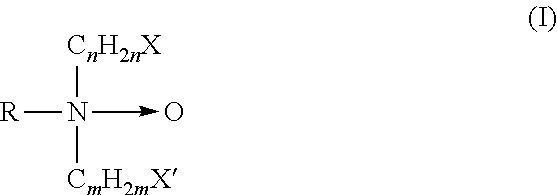Detergent for lithography and method of forming resist pattern with the same
a technology of resist pattern and lithography, which is applied in the direction of photomechanical equipment, originals for photomechanical treatment, instruments, etc., can solve the problems of achieve the effect of reducing pattern falling and defect, improving non-uniformity of pattern width, and low surface tension
- Summary
- Abstract
- Description
- Claims
- Application Information
AI Technical Summary
Benefits of technology
Problems solved by technology
Method used
Image
Examples
example 1
[0074]Four kinds of cleaning solutions for lithography were prepared by dissolving, in pure water, a 1:1 by mole mixture of lauryl dimethyl amine oxide (a product by NOF Corp., product name “UNISAFE A-LM”) and a mixed alkyl (average number of carbon atoms 14) sulfonic acid trimethylamine salt (a product by Takemoto Oil & Fat Co.) in a concentration of 200 ppm, 300 ppm, 400 ppm or 500 ppm, respectively.
[0075]Table 1 shows the defects occurrence rates and the unfallen pattern ratios with these cleaning solutions.
[0076]
TABLE 1Concentration ofRate of defectsRatio of unfallenNo.cleaning solutionoccurrence (%)patterns (%)1200 ppm3.473002300 ppm0.853203400 ppm0.374004500 ppm0.30450
example 2
[0077]Two kinds of cleaning solutions for lithography were prepared by dissolving, in pure water, a 4:1 or 3:2 by moles mixture of lauryl dimethyl amine oxide (LDMO) and a mixed alkylsulfonic acid trimethylamine salt (ASTMA) in a concentration of 400 ppm, respectively. Table 2 shows the defects occurrence rates and the unfallen pattern ratios with these cleaning solutions.
[0078]
TABLE 2Rate of defectsRatio of unfallenNo.LDMO / ASTMAoccurrence (%)patterns (%)14 / 10.3080023 / 20.34300
example 3
[0079]A cleaning solution for lithography was prepared by dissolving, in pure water, a 1:1 by mole mixture of dimethyl myristyl amine oxide (a product by NOF Corp, product name “UNISAFE A-MM”) and the same mixed alkylsulfonic acid trimethylamine salt as used in Example 1 in a concentration of 300 ppm. Table 3 shows the defects occurrence rate and the unfallen pattern ratio with this cleaning solution.
PUM
| Property | Measurement | Unit |
|---|---|---|
| diameter | aaaaa | aaaaa |
| pH | aaaaa | aaaaa |
| pH | aaaaa | aaaaa |
Abstract
Description
Claims
Application Information
 Login to View More
Login to View More - R&D
- Intellectual Property
- Life Sciences
- Materials
- Tech Scout
- Unparalleled Data Quality
- Higher Quality Content
- 60% Fewer Hallucinations
Browse by: Latest US Patents, China's latest patents, Technical Efficacy Thesaurus, Application Domain, Technology Topic, Popular Technical Reports.
© 2025 PatSnap. All rights reserved.Legal|Privacy policy|Modern Slavery Act Transparency Statement|Sitemap|About US| Contact US: help@patsnap.com

